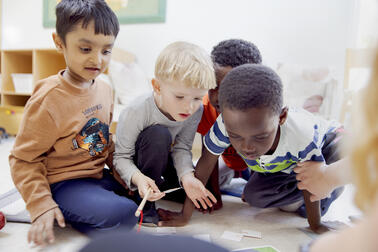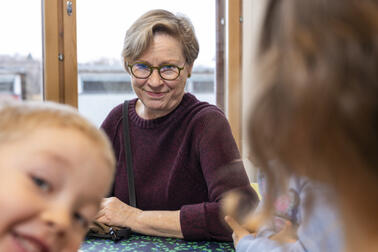3. Adjust the child’s daily schedule
Every group has their own daily schedule in daycare. Depending on the daycare centre, it might look something like this:
- 8.00 Breakfast
- 8.30–11 Play time and guided activities indoors or outdoors
- 11.30 Lunch
- 12.00–14.00 Nap time or rest
- 14.00 Play time
- 14.30 Snack
- 15.00 Outdoor play time and pick-up
The first introductory days are usually short, lasting a couple of hours per day depending on your child's needs. On the first day, we stayed only a couple of hours after breakfast. Our toddler could barely stay awake until the first outdoor session, as she was used to getting her first nap before 10 am. The teacher looked at my toddler napping in the snow toboggan and said it was time for us to go home. Remember that the introduction week can be adjusted according to your child’s needs.
If you want to prepare for the first few days, it might be worth trying to adapt the child’s daily rhythm to the daycare centre group’s schedule. This is easier said than done, which is why you should allow plenty of time for it.
When daycare starts
4. Clear your calendar and prepare for changes
When daycare finally starts, the child can have two close adults with them during the introduction period, which is usually one-week long. For the first day, my spouse and I both decided to go. On the second and third day we took turns. On the fourth day, some of the new children spent the day without their parents or guardians, but we felt that our child still needed a family member’s support and decided to call in grandmother to accompany our toddler.
The child can stay in the daycare centre without their close adults once the service agreement is officially in place. The start date of the agreement is the start date of the early childhood education and early childhood education fee. You can check this on your child's early childhood education decision.
If possible, I recommend you clear some space in your work calendar for the introductory week. Talk to your employer well in advance to arrange any necessary absences. It’s hard to tell in advance how much or little time a child needs to adapt to the group, so changes to the original plan are common.
In the first week, the group teacher will arrange an introductory meeting with each child's parents or guardians. In this meeting, you can discuss your child in more detail and talk about your hopes and needs regarding your child’s early childhood education.
“We can plan the introductory week during the first days and change it according to the family’s and child’s needs. It doesn’t have to look the same for everyone. If we see that the child is adapting well, we can agree that on the next day, the child can spend the whole day at the daycare. Or if it looks like the child is having challenges adjusting, we'll think of ways to support the child," says Lind.
Remember that the daycare centre staff can arrange an interpreter to join the introductory meeting, or any other conversation or meetings with the daycare centre.
“We will always book an interpreter if the family speaks a language other than Finnish. You can still let us know if you would like an interpreter. English interpreters are usually available on a short notice, but for other languages it can take a couple of days to book, depending on the situation. It's always worth asking, even if you need an interpreter tomorrow, or want to talk to the staff in your own language. It's perfectly okay and welcome," says Lind.


